|
|
|
Annual Report 2011-12
|
|
|
|
|
|
|
|
|
|
The real estate sector in India is at a crucial juncture of its evolution. While
a significantly large portion of the industry is still dominated by unorganized
and marginal players; there has been a consistent rise in share of organized players
with number of listed companies growing over the recent years. Arrival of foreign
direct investment, spreading national or regional footprints of organized players
from their traditional city or region of dominance, development breaching the confinement
of metropolitan cities to get reach tier I and tier II cities, rise of commercial
and retail segments together with already residential segment, and fast emergence
of holiday or second home as a category have contributed to a faster transformation
of real estate sector in India over the past decade.
Setting aside the small portion that hospitality segment constitutes, the real estate
sector in India can be classified across Residential Segment, Commercial Segment
and Retail Segment. On the one hand real estate sector has ridden the wave of India’s
economic transformation in the 21st century to grow to its current stature. Yet
at the other hand, it has made a three pronged contribution in strengthening India’s
economic progress. Firstly by raising its direct contribution to a significant 4-5%
of country’s GDP, then by helping the financial sector grow its revenues and earnings
from home loan products, and finally by adding to the overall wealth creation at
the level of its citizens. Besides these, it has also helped in creating millions
of direct and indirect jobs in the country.
Having witnessed accelerated growth between 2003 and 2008, the real estate sector
in India was hit hard by the financial crisis of 2008-09. Having recovered from
sudden jolt, the sector has fast consolidated itself since then. Being a capital
intensive sector; access to and cost of funds plays a significant role for the sellers
as well as the buyers. For the sector, not only has the cost of funding increased
but also access to debt and equity funds have got measured in the recent times.
Last year RBI had increased the standard asset provisioning by commercial banks
for teaser home loans from 0.4 % to 2%, capped the loan to value (LTV) ratio to
80% and increased the risk weight on loans of more than  75 lakh to above 125%. On equity side also the funds availability was limited.
75 lakh to above 125%. On equity side also the funds availability was limited.
-
Very few real estate companies opted to raise capital through IPO route recently.
As a result IPOs markets for the sector has been completely dry since 2011
|
-
FDI in real estate & housing dropped down to
 3326 crore in April 2011 to February 2012 period, from
3326 crore in April 2011 to February 2012 period, from  5149 crore in the previous financial year.
5149 crore in the previous financial year.
-
Private equity financing in real estate sector improved in 2011 with infusion of
$2.68 billion through 53 deals as against $1.58 billion through 58 deals in 2010.
On the flip side, though, a total of 14 divestments from real estate were also announced
by PE financing companies with a combined value of $603 million.
-
During 2011 NRI share in real estate investment increased from an average of 4%
to 8% primarily due to sharp depreciation in INR against most other currencies.
|
FDI Inflow in Housing and Real Estate Sector ( in Crore)
in Crore)
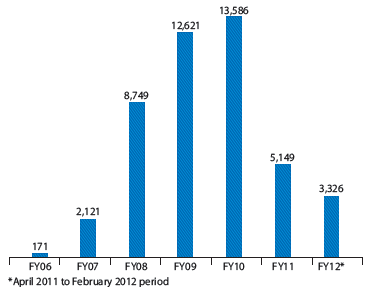
(Source: Dept. of Industrial Policy
& Promotion, Govt. Of India-Apr,2012) |
|
Residential Segment:
Favorable demographics of the country have led to a healthy growth of real estate
market in the residential sector. Improving socio-economic factors are leading to
a consistent fall in the average age of ownership of the first house and consistent
increase in the number of house owned. The rising demand and limited availability
of the dwelling units within the city limits will continue and the same would result
in higher prices of residential real estate. A recent study by CRISIL estimates
the overall housing shortage in India to reach 75.5 million units by the end of
2014 and suggests the housing prices to consolidate between 2010 and 2014 period. |
CityWise Housing Price Index
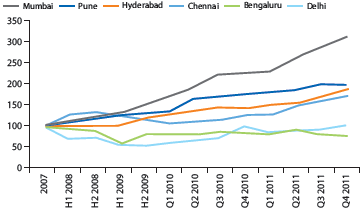
During the financial year 2011-12, led by hardening of interest rate, macro uncertainities
and sharp increase in capital value of residential units post 2008-09 financial
crisis slowed down the demand momentum in most cities. Despite that, the capital
value of residential market in most cities continued to remain stable with a positive
bias. While in cities like Bangalore and Hyderabad the prices are still at or below
the 2007 level, in most other cities prices have more than doubled during the same
period.
Commercial Space:
The commercial office space in India has fast evolved over recent years with the emergence of India as an IT/ITeS hub. As shown in the graph below, the demand of
commercial real estate has been driven largely by services sectors.
|
Commercial properties earlier were majorly concentrated towards Central Business
District areas in large cities. However, with the huge office space requirement,
commercial development started moving towards other areas like Lower Parel & BKC
in Mumbai, Gurgaon near New Delhi and the Electronic city in Bengaluru (Bangalore). In addition locations such as Bengaluru, Gurgaon, Hyderabad, Chennai and Pune have established themselves as emerging destinations for commercial development. |
Leasing of Offices Space by Various Sectors
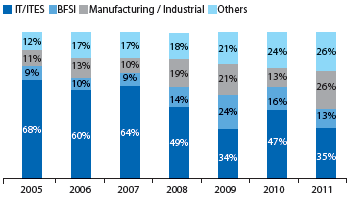
Source: Real Estate Intelligence
Service ( JLL), 4Q11
|
During 2011 while the new completion increased by 9.1% to 44.5 msf, the demand grew
by 20.3% to 36.7 msf. As per JLL report, in 2012 while the new completion would
increase by 20%, the demand would contract by 7%, driving vacancy rates further
up.
According to CRISIL Research in 2010, commercial office lease rentals may show an
additional correction of another 3-10% in most of micro markets primarily due to
the considerable oversupply across cities and lack of adequate demand.
|

|
Supply And Demand Of Office Space(msf)
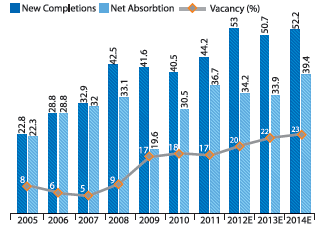
Source: Real Estate Intelligence
Service (JLL), 4Q11
Supply, Net Absorbtion And Vacancy Of Retail Space In India
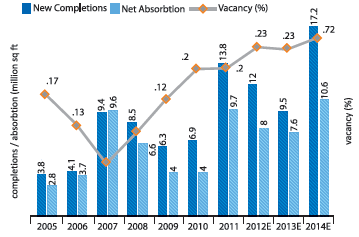
Source: Real Estate Intelligence
Service (JLL), 4Q11
Retail:
Organized retail penetration has grown to about 5.6 % in 2009-10, which is further
expected to increase to about 7.3 % by 2012-13, according to a CRISIL report for
real estate. In the past few years,
India’s organized retail industry has posted
high growth rates giving improvement in key driving factors namely, lavish lifestyles
and high disposable incomes. The US-based global management consulting firm, A T
Kearney, in its Global Retail Development Index (GRDI) 2011, has ranked India as
the fourth most attractive nation for retail investment, among 30 emerging markets.
After growing at high rate over the last decade, the organized retail industry in
India witnessed a sudden slowdown in investments after financial crisis in 2008-
09 which led to large build up in supply. During 2011, fresh completion doubled
to 13.8 msf and absorption increased by over 140% to 9.7 msf. This also led to further
increase in vacancy rate. As per JLL report in 2012 the demand is expected to slow
down to 8 msf. Going forward, due to weak demand environment and lack of any evident
demand trigger, the lease rentals are expected to remain under pressure.
The absence of a clear approval towards FDI in multibrand retail segment has also
played a key role in disturbing the demand-supply curve, as fresh demand has slowed
down. Corrective measures such as reforms from government and right pricing of lease
rentals & selling prices may help in due course of time.
|
|
|
|